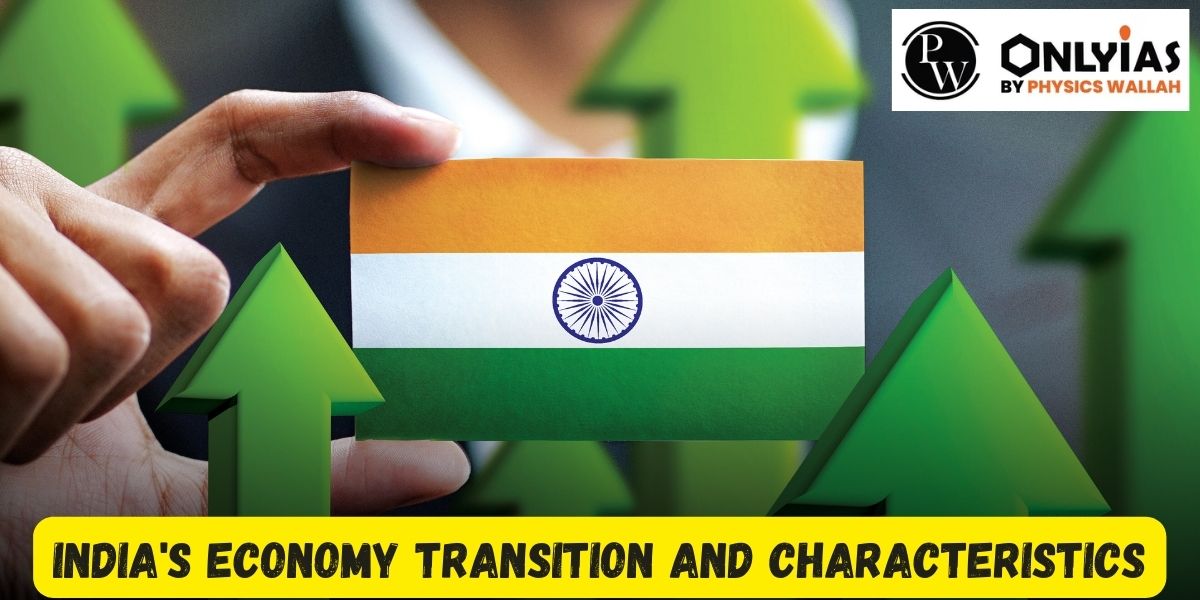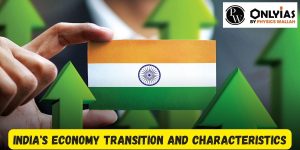India's Economy Transition and Characteristics: India, known for its rich cultural heritage, diverse landscapes, and bustling cities, is also making waves on the global economic stage.

India, known for its rich cultural heritage, diverse landscapes, and bustling cities, is also making waves on the global economic stage. In recent decades, the country has undergone a remarkable economic transition, transforming from a predominantly agrarian economy to one of the world’s fastest-growing emerging markets. This article delves into the key characteristics and the remarkable journey of India’s economy.
India’s economy has undergone a transformation from a mixed planned economy to a mixed middle-income developing social market economy. It stands as the largest economy in South Asia and boasts a notable public sector presence in strategic industries. India ranks as the world’s fifth-largest economy by nominal GDP and the third-largest by purchasing power parity (PPP). According to the International Monetary Fund (IMF), India is 139th in GDP (nominal) per capita and 127th in GDP (PPP) per capita.

India’s economic landscape has undergone a significant transformation, evolving from a mixed planned economy to a middle-income developing social market economy. It now stands as the largest economy in South Asia, featuring a prominent public sector in key strategic industries. India ranks as the world’s fifth-largest economy when measured by nominal GDP and the third-largest when evaluated using purchasing power parity (PPP). According to data from the International Monetary Fund (IMF), India’s per capita income places it at 139th in terms of GDP (nominal) and 127th in terms of GDP (PPP).
India’s economic history is a tapestry of complex patterns. For centuries, agriculture was the primary source of livelihood for the majority of the population. However, this began to change in the 1990s when the Indian government initiated economic reforms, embracing globalization and liberalization. These reforms opened up doors to foreign investment, reduced trade barriers, and encouraged private enterprise. This shift marked the beginning of India’s modern economic transformation.
Historically, from its independence in 1947 until 1991, India followed a Soviet-style economic model, characterized by protectionist policies, extensive state intervention, state-owned enterprises, and economic regulations, known as the “License Raj.” However, the end of the Cold War and a severe balance of payments crisis in 1991 led to a broad economic liberalization and indicative planning in India.
The end of the Cold War and a severe balance of payments crisis in 1991 prompted India to embrace a comprehensive program of economic liberalization and indicative planning. Since the beginning of the 21st century, India has maintained an annual average GDP growth rate ranging from 6% to 7%.
It’s worth noting that prior to the onset of colonialism in the early 19th century, the Indian subcontinent boasted the world’s largest economy for much of recorded history. In 2022, India accounted for 7.2% of the global economy in terms of PPP and approximately 3.4% in nominal terms.
One of India’s most significant economic advantages is its demographic dividend. With a youthful population and a growing workforce, India has a massive pool of human resources, which, if harnessed effectively, can drive economic growth for decades to come. This advantage, however, also comes with the challenge of providing employment opportunities and skilling the workforce adequately.
India’s economy has witnessed a notable shift towards the services sector. Information technology, business process outsourcing, and software development have become major contributors to the nation’s GDP. Cities like Bangalore, Hyderabad, and Pune have emerged as global tech hubs, attracting both domestic and international companies. The services sector’s prominence has positioned India as a global outsourcing destination.
India’s economy still includes informal domestic sectors, with COVID-19 causing disruptions in both economic growth and poverty reduction. Weaknesses in credit access have contributed to lower private consumption and inflation, necessitating new efforts to address social and infrastructure equity.
Economic growth faced a slowdown in 2017 due to the shocks of “demonetization” in 2016 and the introduction of the Goods and Services Tax in 2017. Nearly 70% of India’s GDP stems from domestic consumption, making it the world’s sixth-largest consumer market. Besides private consumption, India’s GDP is driven by government spending, investments, and exports. In 2022, India was the world’s sixth-largest importer and ninth-largest exporter, having been a member of the World Trade Organization since January 1, 1995. India’s nominal GDP fluctuates significantly due to extreme rupee-to-dollar rate fluctuations.
The service sector contributes over 50% of India’s GDP and continues to be the fastest-growing sector. The industrial and agricultural sectors employ the majority of the labor force. India is home to two of the world’s largest stock exchanges, the Bombay Stock Exchange and National Stock Exchange, by market capitalization. It ranks as the world’s sixth-largest manufacturer, accounting for 2.6% of global manufacturing output. Approximately 65% of India’s population resides in rural areas, contributing about 50% to India’s GDP. The nation also holds the world’s fifth-largest foreign exchange reserves, amounting to $561 billion.
To further diversify the economy and create employment opportunities, India has been promoting its manufacturing sector. Initiatives like “Make in India” aim to encourage domestic production and attract foreign investment. The growth of manufacturing is essential for reducing dependency on imports and boosting exports.
The industrial sector plays a substantial role in India’s economy, contributing to 26% of the GDP and employing 22% of the total workforce. Mumbai, often regarded as the industrial capital, serves as a prominent hub in this regard.
India’s industrial sector contributes 26% to its GDP and employs 22% of the workforce, with Mumbai as a major industrial hub. In 2015, India ranked 6th globally in industrial manufacturing GDP output at $559 billion (current US dollars) and 9th at $197.1 billion (constant 2005 US dollars).
The 1991 economic reforms transformed the industrial landscape by removing import restrictions, inviting foreign competition, privatizing state-owned industries, and liberalizing foreign direct investment. This led to increased production of consumer goods but reduced employment opportunities.
India is a major player in coal, agrochemicals, cement, steel, and electricity production, ranking 2nd in most of these categories worldwide.
Infrastructure development plays a crucial role in sustaining economic growth. India has embarked on ambitious projects to enhance its infrastructure, such as the construction of new highways, railways, ports, and airports. Improved connectivity not only facilitates trade but also promotes regional development.
India operates 131 airports, including 29 international, 92 domestic, and 10 Custom airports. Additionally, the government has granted in-principle approvals for 21 new greenfield airports as of June 2023.
Despite challenges faced by advanced economies, India is committing a substantial Rs 10 lakh crore (3.3% of GDP) for infrastructure in the 2023-24 budget, supported by loans to state governments totaling Rs 1.3 lakh crore for infrastructure investments.
The government is also focusing on large-scale development, exemplified by 144 ongoing tunneling projects covering 357 km on National Highways. These tunnels significantly reduce travel distances and time.
While India’s project execution has improved, recent rail and road accidents underscore the importance of meticulous planning and quality execution. Legacy issues such as land acquisition, funding, and the adoption of modern technologies remain challenges.
Funding long-term infrastructure projects poses a significant challenge, as government resources are limited, and banks and institutions face asset-liability risks with short-term funding for such projects. To address this, India is exploring Infrastructure Bonds and encouraging Foreign Direct Investment (FDI). Public-Private Partnerships (PPP) are already a common approach in implementing infrastructure projects.
Despite its rapid economic growth, India faces various challenges, including income inequality, poverty, and unemployment. Balancing economic growth with social development remains a significant policy challenge. Additionally, addressing environmental concerns and sustainable development is crucial to ensuring the long-term health of the economy.
India is increasingly integrated into the global economy. It is a member of various international organizations and has entered into several trade agreements. Global partnerships and collaborations are critical for enhancing India’s economic standing on the world stage.
With a labor force of 476 million, India boasts the world’s second-largest workforce. It also experiences significant income inequality, with one of the highest numbers of billionaires globally. Despite efforts to expand the tax base, the number of taxpayers in India remains relatively small at around 6.25% of the population.
During the 2008 global financial crisis, India employed Keynesian policies, including fiscal and monetary stimulus measures, to boost growth and demand. The subsequent years saw a revival in economic growth. The World Bank emphasizes the need for public sector reform, infrastructure development, agricultural and rural progress, deregulation of land and labor, financial inclusion, increased private investment and exports, education, and public health to achieve sustainable economic development in India.
In 2022, India’s top trading partners were the United States, China, United Arab Emirates (UAE), Saudi Arabia, Russia, Germany, Hong Kong, Indonesia, South Korea, and Malaysia. Foreign direct investment (FDI) in India reached $82 billion in 2021–22, with the service sector, computer industry, and telecom industry leading in FDI inflows. India has free trade agreements with numerous nations and blocs, including ASEAN, SAFTA, Mercosur, South Korea, Japan, Australia, UAE, and others, some of which are in effect, while others are in the negotiating stage.
India faces challenges such as high public debt, standing at 83% of GDP, a fiscal deficit of 6.4% of GDP, high unemployment, rising income inequality, and declining aggregate demand. Moreover, India’s gross domestic savings rate reached 29.3% of GDP in 2022. In recent years, independent economists and financial institutions have raised concerns about the government’s manipulation of various economic data, especially regarding GDP growth. India’s overall social spending as a share of GDP in 2021–22 is relatively low at 8.6%, compared to the average for OECD nations.

| Also Read: | |
| 7 Best Books for Indian Economy for UPSC 2024 | UPSC Economics Syllabus |
| FRBM Act UPSC | G20 Summit 2023 Delhi Schedule |
India's current economic status can be characterized as that of a developing and emerging economy. It falls into the category of a lower-middle-income economy and is also classified as a newly industrialized country.
The United States has maintained its position as the world's leading economy and the wealthiest nation, consistently holding this top spot from 1960 to 2023.
As per the World GDP Ranking for 2023, India holds the fifth position in the global economy. Notably, countries such as the United States of America, China, Japan, Germany, and others also feature prominently on this GDP Ranking list.

<div class="new-fform">
</div>